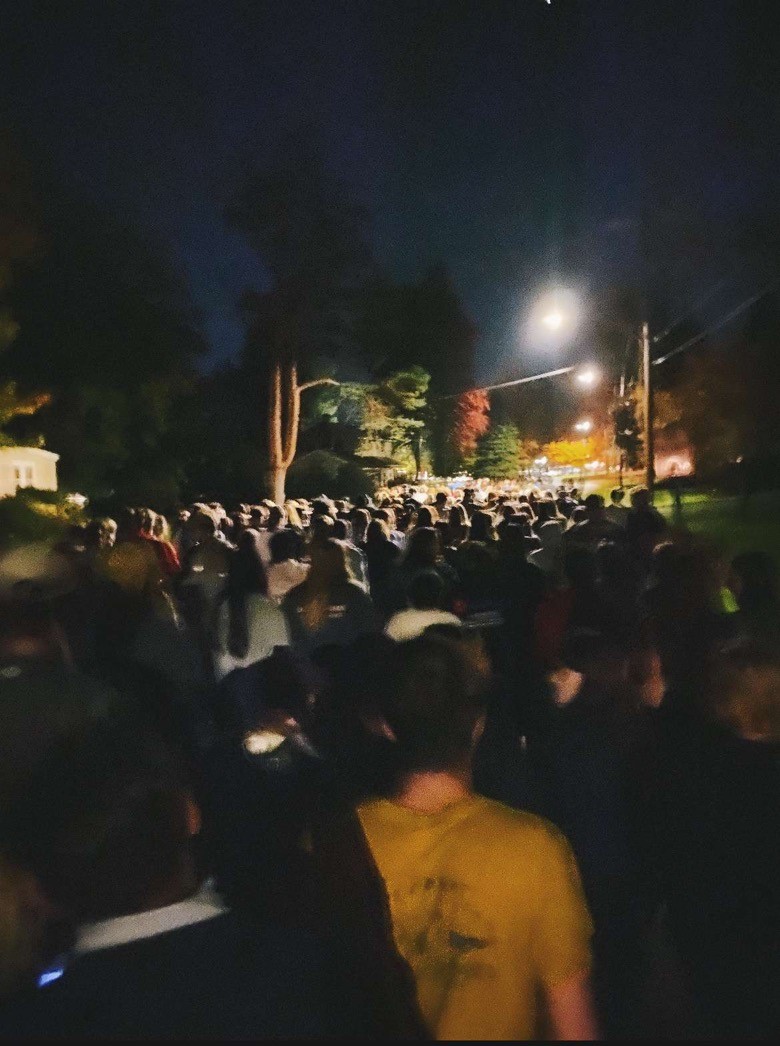TW: SA
More than 200 St. Lawrence students protested against the current sexual misconduct policy on Oct. 12. Protesters shared their experiences with sexual assault on campus and questioned the administration’s response to sexual assault on the MacAllaster lawn in front of St. Lawrence President Kate Morris and Student Life leaders John O’Connor, Hagi Bradley, Chris Marquart, and Maverick Cummings.
The protest began after Assistant Vice President of Safety and Security Patrick Gagnon sent an email about “a report of sexual assault in Jencks Hall” to the student body. Some people—such as the founder of the new campus organization The Nine Coalition, who helped organize the protest and asked to remain anonymous in order to protect their identity from past abusers—were upset with the administration for not releasing more details on the suspect. Through the popular social media app “Yik Yak,” students began sharing the names of their assaulters, expressing anger toward the survivors’ lack of justice, and voicing their concerns with safety.
“Before the protest, I met up with someone, who had expressed to me that she kind of knows one of the people that was mentioned on Yik Yak, and she was upset about it,” said The Nine Coalition founder. “One of the people’s names mentioned is in one of my classes, and
another person mentioned I’ve talked to, so it’s kind of scary knowing that we are living with these people without even knowing who they are.”
In consensus about the concerns of St. Lawrence’s sexual misconduct policy, an anonymous group of “Yik Yak” users agreed to peacefully protest in front of President Morris’ house from 9-10 pm. According to The Nine Coalition founder, the expectation for the protest was about 15 people. However, the turnout was much higher and diverse than expected.
“It was really good to see different people, like international students were there, and both men and women were there,” the founder of The Nine Coalition recalled. “It definitely shows us that this isn’t a single issue. No matter your race, gender, culture, sexuality, this is a problem. And everybody is, in some ways, affected by it.”
In fact, during the protest, one of the impromptu leaders of the protest Hannah Spaeth ’23 asked the students in attendance to stand up if they have been sexually assaulted or know someone who has been sexually assaulted on campus. “Pretty much everyone out of the hundreds of people that were there stood up,” she said. “Then, it was stay standing if they reported it, went through the whole process and that person [the assaulter] was expelled. And almost everyone sat down.”
“I don’t think the administration realized, until that moment, exactly how widespread this issue was,” Spaeth said.
Assistant Dean of Student Life and Deputy Title IX Coordinator John O’Connor, who attended the protest, recognized the amount of students impacted by sexual assault. “I thought it was just a really well organized event for something that came together last minute,” he said.
“I think it sort of speaks to the number of students that the issue resonates with, and it’s something they want to make sure it gets better for the Laurentian community.”
During protest, there were instances when both administrators and students expressed frustration with each other. “I thought the conversation was constructive, but, sometimes, I felt both sides weren’t really listening to each other,” protestor Brenna McConnell ’23 said.
“There was a lot of student anger, but the anger is rightfully placed because I am completely with the students that there is no place for sexual assault in society, or on our campus,” Morris recalled. “I appreciated that the students had a passion to make things better”
Since the protest, administrators and the student body are working towards addressing the protesters’ concerns. The administrators plan to, if they have not yet already, host an open forum, in which students may ask questions about the campus’ sexual misconduct policy, according to O’Connor.
Morris added that the university is in the process of hiring a dedicated Title IX Coordinator. In the past, the Title IX Coordinator held other positions in addition to managing sexual misconduct, and currently the university only has an interim Title IX Coordinator. Associate Dean for Diversity and Inclusion Kimberly Flint-Hamilton became the new interim Title IX Coordinator after Debra Mousaw resigned from the role on Oct. 15.
Morris believes that instituting a full-time Title IX Coordinator will encourage victims of sexual assault to come forward. “What we found at my prior institution was when we created that position as a free standing role, rather than having it be part of somebody’s job, the number of reports went up quite a lot,” she said.
Students have also been taking action. For example, a day after the protest, Spaeth created the petition “Change the Culture at St. Lawrence University,” summarizing the protest’s main requests in three goals. In the petition, she asked the administration for an open forum to answer questions about the current sexual misconduct policy, funding for in-person sexual assault resources, and a zero-tolerance policy for perpetrators of sexual assault. She has 674 signatures, as of Oct. 19.
“I think we got as much out of it as you can get from a protest, and that was attention. We got the attention of the administration, we got attention of the student body,” Spaeth said. “If the protests had never happened, I doubt that petition would be getting the attention it’s getting.”



